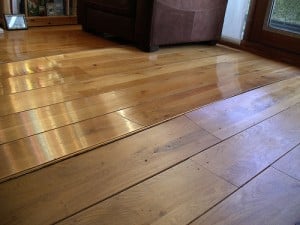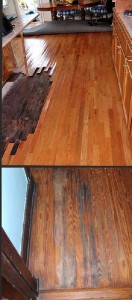Restoration On A Damaged Hardwood Floor
You might be familiar with this situation: you have recently installed beautiful cherry wood floors and then you notice the thing most dreaded by homeowners…..warped floor boards. Your first instinct might be to fix the floor. A word of caution, though: are you ready for what you might find?
Repairing damage on a hardwood floor is a task that may be necessary from time to time on a small scale with intermittent spillages or minor leaks. Alternatively you may be faced with major damage following flood or a large body of water that has saturated your hardwood floorboards.
Repairing Minor Hardwood Floor Damage

Firstly, make sure you have identified the source of the damage from water and fixed it completely. Any later repair work will be for nothing if you do not seal the leak or repair the pipes from where the water is coming.
Next, you may be faced with a spot that is discolored and possibly swollen and cracked or warped. The wood grain has become affected by the damage and has reacted. Dry out the affected area until it is completely dry before beginning any restoration work on it.
Begin by sanding back the affected area starting with a coarse sandpaper before moving back to a finer grit. Once the area has been sanded back and the stain edges are smooth treat the area with a wood sealant that matches the rest of the floor. Following one coat of sealant it may be necessary to sand it back before adding another coat.
Some kind of blending process may have to be done so that the damaged area winds up looking the same as the original floor.
Major Hardwood Floor Damage Repair
When a lot of moisture has been absorbed by a hardwood floor the most common result is that the wood expands. When the boards expand they become wider and one of two things might happen, you might have a buckled floor or you may have a floor that is cupped. In either case you are left with a seriously uneven floor.


Once the floor has been properly dried and the moisture is removed from the surrounding area, the floor can be sanded back and refinished so that it is returned to its original smoothness again. If the hardwood floor has become so buckled that it has come completely away from the subfloor to which it was attached it may be necessary to call in a hardwood floor installer to reattach the planks.
In all cases when dealing with repairing hardwood floor damage the key to a successful restoration is to completely remove the moisture that caused the original damage in the first place. No matter how carefully you carry out your restoration, if you haven’t fixed the origin of the water the problem will return and cost you even more of both your time and money.
Damage from water can be devastating and drying of hardwood floors from damage should be done as soon as possible by experienced certified professionals.
Every situation is different and the possibility of performing a restoration on a damaged hardwood floor may be dependent on the quality of water that damaged the floor, the length of time that the floor was exposed to the water or the state of the subfloor itself. If you are in doubt it is advisable to contact a Minnesota Damage Restoration Expert for advice.




